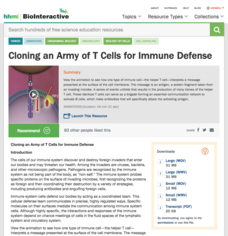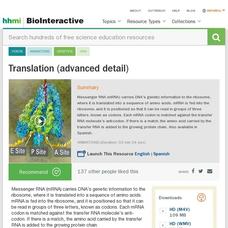Howard Hughes Medical Institute
Lactose Digestion in Infants
Milk meets every single nutritional need for a baby in the first six months of life. Observe how an infant's small intestine breaks milk lactose down into a usable form of nutrition. With the help of an animation, viewers see the process...
PBS
How Two Microbes Changed History
Where would we be without bacteria? As it turns out, we owe them everything! Introduce young biologists to endosymbiotic theory using an amazing video from an extensive biology playlist. Scholars discover the bacteria that may be...
Crash Course
Water - Liquid Awesome
If H2O is water and H2O2 is hydrogen peroxide, what is H2O4? Drinking, bathing, and cooking among others. Viewers of a short video explore water through its molecular structure, its ability to stick to itself through adhesion (cohesion...
Socratica
Chemistry: Ionic Bonds vs Covalent Bonds (Which is Stronger?)
Both ionic and covalent bonds present as strong bonds, but which is stronger? Socratica presents a video from its chemistry playlist that attempts to answer this question. It addresses how strength is measured and the range of strengths...
Stated Clearly
What is DNA and How Does it Work?
Explaining exactly how DNA works to provide genetic information is a complex topic, but it is presented in a clear and engaging way through a five-minute video. Have learners try to explain how DNA works before watching the video, then...
Curated OER
STEMbite: Diffusion
A biology or physical science class would benefit from viewing this video on diffusion and molecular motion. Mr. Vanden Heuvel plays with food coloring in drinking glasses, showing that the faster the water molecules are moving due to...
Howard Hughes Medical Institute
Cloning an Army of T Cells for Immune Defense
How do bodies fight infections and illnesses? An animation of the way T cells clone to fight an infection provides many details. The resource also provides an excellent written introduction and ideas for how to ensure pupils understand...
Curated OER
Introduction to Heredity
Young scientists generally love to learn how certain traits can be explained by a direct combination of alleles from their parents. Here, they are able to examine how a phenotype is often expressed as a result of one allele being...
Curated OER
Anatomy of a Muscle Cell
Previous videos have dealt with the proteins that produce mechanical motion and how nerves stimulate contraction. But this presentation explains on a gross anatomical scale, how skeletal muscle is structured.
Socratica
Chemistry: What Is a Metal? (Metallic Bonds)
Metals offer unique properties thanks to the structure of their valence electrons. The Socratica chemistry playlist includes this video explaining what a metal is and the properties of metals. It focuses on their structures, features,...
Socratica
Empirical Formula
With empirical formulas, it's all about keeping it simple! Introduce the concept of empirical formula to your chemistry scholars through a detailed video from Socratica's Chemistry Lessons series. The resource uses visual...
Socratica
Chemistry: What Is an Ionic Bond?
Teach your class all they want to know about ionic bonds. An engaging video, part of the Socratica "Chemistry Lessons" playlist, explains what ionic bonds are and how they form. It describes multiple examples of ionic bonds and...
Socratica
Chemistry: What Is a Covalent Bond? (Polar and Nonpolar)
When it comes to covalent bonding, sharing is caring! As part of the Socratica chemistry playlist, a useful video explains the definition of covalent bonding. Then, it works through examples of single bonding, double bonding, polar...
Socratica
Chemistry: Stoichiometry Part 2—Mass to Mass Conversions
The term stoichiometry derives from the Greek words stoicheion meaning element and metron meaning measure. The second Socratica video in a two-part series within a larger chemistry playlist introduces more complex stoichiometry...
Socratica
Chemistry: Balancing Chemical Equations—Algebraic Method
If you love algebra, then you're gonna love this balancing method! Introduce young chemists to the algebraic method of balancing chemical equations using a video from an informative chemistry playlist. The narrator works five...
Socratica
Chemistry: Introduction to Unit Conversion and Dimensional Analysis (Part 2)
If you know how much carbon dioxide you produce in one breath, can you figure out how much you produce in one month? Socratica helps solve multi-step unit conversion problems. The video walks through how to set up these challenges and...
Socratica
Chemistry: Average Atomic Mass (AMU, Daltons, etc.)
Scientists created a new measurement, the atomic mass unit, which is defined as carbon 12 = 12amu. So why isn't carbon listed as having exactly 12 amu on the periodic table? An installment from the Socratica chemistry playlist answers...
Socratica
Chemistry: Percent Composition
How much oxygen is in water? Is it the same as the chemical formula? Learners observe the differences between a substance's formula and its percent composition with a video from Socratica's Chemistry Lessons series. The narrator...
Howard Hughes Medical Institute
Repellant Ephrin Signals Guide Limb Innervations
The foot bone connects to the leg bone, but how? Learn about how neurons grow in the proper direction thanks to signalling. Observe what happens when they encounter a repulsive ephrin signal and the correction process that takes place.
Howard Hughes Medical Institute
Neurons in Parietal Cortex Are Active During Straddling
How do scientists know which parts of the brain various functions use? With the help of an animated cat, viewers observe this process. They listen to the activity of one neuron as the cat steps over an obstacle and hear when the neuron...
Howard Hughes Medical Institute
Measuring Circadian Activity in Drosophila
How many hours should be in a day? One species of drosophila naturally prefers a 24.5 hour day, while another strongly prefers a 19-hour day. An animation and graph share data from each of these species when exposed to the typical light...
PBS
When Insects First Flew
Insects developed wings and the ability to fly earlier than any other animal—when exactly did that happen? Scientists know this fact but struggle to explain when insect wings developed and how this entirely new structure appeared. PBS...
Howard Hughes Medical Institute
Translation (Advanced Detail)
Who said staying predictable is a bad thing? Translation follows a predictable four-step process. Scholars view a summary of each step with a breakdown of every detail, then examine different functions, highlighted with different colors,...
Be Smart
3 Incredible Examples of Evolution Hidden in Your Body
Human traits trace back to simpler species—such as chickens, for example. Using the human genomes, scientists connect these traits to their ancestral origins. A video presentation highlights the structure of human DNA and makes a...
Other popular searches
- Cell and Molecular Biology
- History of Molecular Biology
- Molecular Biology Software
- Molecular Biology Models
- Molecular Biology Organic
- Evolutionary Molecular Biology
- Molecular Biology of Gene
- Cellular Molecular Biology
- Molecular Biology Vido
- Molecular Biology Vi Do
- Cellular and Molecular Biology
- Molecular Biology Video

























